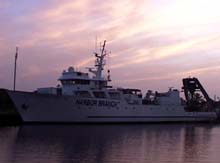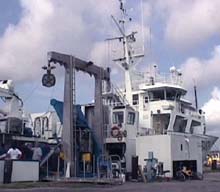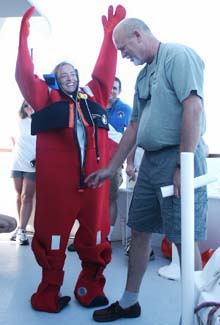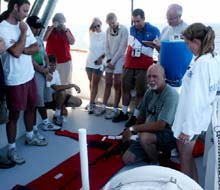
The R/V Seward Johnson at the HBOI dock around sunrise on the first morning of IIS 2002. Click image for larger view.
Expedition Mobilization and Safety at Sea
July 27, 2002
Robin Salonich, Teacher
Sandhills Intermediate School
Jeremy Potter
NOAA Office of Ocean Exploration
![]() Watch a video of the R/V Seward Johnson as scientists prepare her for the upcoming expedition. (mp4, 2.7 MB)
Watch a video of the R/V Seward Johnson as scientists prepare her for the upcoming expedition. (mp4, 2.7 MB)
Scientists and journalists are increasingly finding new ways to communicate the excitement of discovery to the public. By capitalizing on the magic of the undersea realm, magazines, television, and the Internet incorporate video, photographs, and colorful maps to highlight the important advances in scientific understanding gained through every new expedition in the world’s oceans. Athough these media outlets provide wonderful explanations of the ongoing science, they often overlook the months—and sometimes years—of planning and preparation that take place before any underwater submersible dives, before any sample is collected, or even before any research vessel leaves port. Mission planning and coordination is a prerequisite for any safe, organized and productive expedition.

The crew and science party prepare the ship and equipment for departure on afternoon of July 27. Click image for larger view.
Mission planning for this expedition began on May 31, 2002, when Islands in the Stream 2002 (IIS 2002) Mission Coordinators Paul Orlando and John McDonough gathered scientists together at the National Undersea Research Center (NURC) at the University of North Carolina Wilmington ![]() . Though many of the scientists involved in IIS 2002 have been working off the coast of the southeastern United States for years, this 35-day research cruise aboard Harbor Branch Oceanographic Institution
. Though many of the scientists involved in IIS 2002 have been working off the coast of the southeastern United States for years, this 35-day research cruise aboard Harbor Branch Oceanographic Institution ![]() ’s (HBOI) R/V Seward Johnson will be the first time that many of them will work together. In addition to producing a preliminary mission schedule, this face-to-face meeting helped foster collegial working relationships among the scientists that are necessary for planning any successful multidisciplinary expedition. After this initial day, planning continued via hundreds of email messages and phone conversations.
’s (HBOI) R/V Seward Johnson will be the first time that many of them will work together. In addition to producing a preliminary mission schedule, this face-to-face meeting helped foster collegial working relationships among the scientists that are necessary for planning any successful multidisciplinary expedition. After this initial day, planning continued via hundreds of email messages and phone conversations.
George Sedberry of the South Carolina Department of Natural Resources ![]() is the chief scientist for the first leg of IIS 2002. His scientific party arrived late in the morning on July 27th at HBOI in Ft. Pierce, Florida. Cruise mobilization required that scientists and crew load dozens of boxes and crates prior to departure. These supplies and equipment containing everything from microscopes and computers to toilet paper and bananas need to be properly set-up with bungee cords, rope, and Velcro strips, or stowed away to prevent damage in the event of strong seas.
is the chief scientist for the first leg of IIS 2002. His scientific party arrived late in the morning on July 27th at HBOI in Ft. Pierce, Florida. Cruise mobilization required that scientists and crew load dozens of boxes and crates prior to departure. These supplies and equipment containing everything from microscopes and computers to toilet paper and bananas need to be properly set-up with bungee cords, rope, and Velcro strips, or stowed away to prevent damage in the event of strong seas.
Safety
As Robin Salonich, a fifth-grade teacher at Sandhills Intermediate School in Swansea, South Carolina, found out, large waves and strong winds are not the only safety concerns at sea.
Collecting Benthic Animals
"One of the main concerns I had prior to embarking on this journey was safety. What happens on the vessel in the event of a fire, man overboard, or a catastrophic event and we all have to abandon ship? The captain of the R/V Seward Johnson, Ralph Van Hoek, discussed all of the contingency plans during a mandatory drill meeting after dinner on the first night. The ship’s crew is obviously well prepared. I feel that because the captain has had every crew member jump into the water using Immersion Suits, they really do know what they’re doing. The confidence they relayed to me during the drills makes me feel very confident about the rest of the journey!”
Here are Robin’s notes from the safety meeting with Capt. Ralph Van Hoek.
Fire:
In the event of a fire, report to a pre-determined muster point. Upon arrival at the muster point, the Chief Scientist takes a head count and reports to the captain. The crew of the R/V Seward Johnson will battle the fire while we wait for further instructions.
Man Overboard:
This is a phrase no captain wants to hear. However, knowing the procedures may mean the difference between life and death. It is important to throw the fallen person a life ring for two reasons—first as a flotation device, and second, as an identification marker for the captain.
Immersion Suit:
One of the more funny-looking yet extremely useful devices is the immersion suit. For me, it resembles a red version of “Gumby,” the green doll of yesteryear. It comes with a whistle and a water-activated light. These suits are designed to maintain proper body temperature and keep you buoyant in the event that we must abandoned ship.

Lisa Hollen, a graduate student at the University of Charleston and the last science party member to arrive for the safety briefing, gets the 'privilege' of trying on the immersion suit. Click image for larger view.
Life Rafts:
There are four rafts located in various spots on the vessel. In the highly unlikely event that the ship sinks before crew has time to deploy the rafts, each one has a hydrostatic release mechanism. Because water pressure increases with depth, when the ship sinks below a certain depth, the hydrostatic switch automatically releases, allowing the raft to open and float to the service. A single life raft is equipped with enough food, water, and seasick pills for 25 people.
EPIRB:
This is an acronym for Emergency Position Indicating Radio Beacon. A member of the crew, in the event of an abandoned ship, removes the EPIRD from its cradle. It allows searchers to locate the vessel quickly, using GPS coordinates.
Robin summarized the meeting well. “Everyone on board has a responsibility in the event of an emergency, the least of which is the ability to take care of oneself. After being given this information, my concerns have been calmed. I realize as we start on our journey the best is yet to come, and knowing what to do in the event of an emergency will only benefit the entire crew.“
Sign up for the Ocean Explorer E-mail Update List.















































